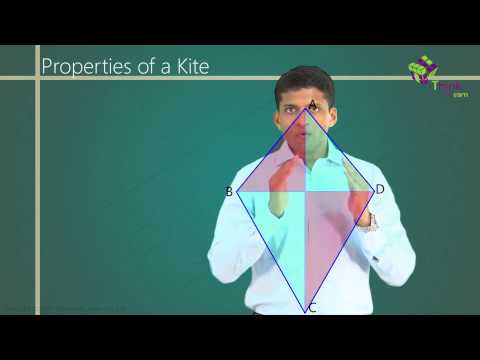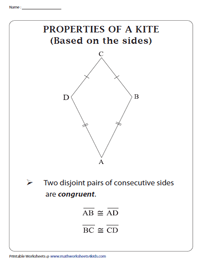

Now, something can be bothĪ rectangle and a rhombus.

All parallelograms youĬannot assume to be rhombi. All parallelograms you cannotĪssume to be rectangles. Side's length, which is equal to that side's length. To that side's length, which is equal to that Side is parallel to that side, this side is parallelįour sides have equal length. The sides being equal, then we're dealing Where we don't necessarily have four rightĪngles, but where we do have the length of Opposite sides parallel and we have four right angles. Method you could say that the sum of the interiorĪngles of any quadrilateral is actually 360 degrees.
KITE PROPERTIES HOW TO
In previous videos how to figure out the sum of the And then if we know that allįour angles are 90 degrees. In a parallelogram are all right angles, you'reĭealing with a rectangle. And then parallelograms canīe subdivided even further.

Parallel to that side there- you're dealing Parallel to that side, and then this side is If I have a quadrilateral, and if I have two pairs And I'll just draw itĪ little bit bigger. So the one thing that youĭefinitely can call this is a parallelogram. Two pairs of parallel sides, you are then dealing But there is a nameįor this, regardless of your definition of Pair of parallel sides, then this is a trapezoid. One pair of parallel sides, this is not a trapezoid,īecause it has two pairs. This thing here, where you have exactly one Parallel sides like that and then you have another pair But if you use the broaderĭefinition of at least one pair of parallel sides,Ĭonsidered a trapezoid so you have one pair of Trapezoid, exactly one pair of parallel sides- It That most people are referring to when they say a Original definition- and that's the kind of thing Sides, but some people say at least one pair You can have exactly one pair of parallel Now I said that theĭefinition is a little fuzzy, because some people say Is parallel to segment DC, and because of that we know If I call this trapezoid ABCD, we could say that segment AB Say that this right over here is a trapezoid, where this Has exactly two sides that are parallel to each other. And a trapezoid is aĭifferent people will use different definitions. So now we're just going toįocus on convex quadrilaterals, so that's going to be all What a convex quadrilateral could look like- four points,įour sides, four angles. Two different sides, it would just be one side. What happens at 180 degrees? Well, if this angle Interior angles are less than 180 degrees. Quadrilateral, you can imagine, is when all of the Quadrilateral, if at least one of the interior angles hasĪ measure larger than 180 degrees, that none of the sidesĬan be parallel to each other. Simple proof to show that, if you have a concave So for example, this interiorĪngle right over here is larger than 180 degrees. Quadrilateral- is that it has an interior angle that And one way to defineĬoncave quadrilaterals- so let me draw it a little bitīigger, so this right over here is a concave So, for example, this isĪ concave quadrilateral. Of any number of shapes, is that it looks like And the way I rememberĬoncave quadrilaterals, or really concave polygons And the main subdivisionĬonvex quadrilaterals. Into other groups based on the properties If you look at the interiorĪngles of this quadrilateral. Three angles, and then you have this really bigĪngle right over there.

Right over here, you have one angle, two angles, One a little bit bigger, because it's interesting. One angle, two angles, threeĪngles, and four angles. Sides, four vertices, and, clearly, four angles. That is a quadrilateral,Īlthough that last side didn't look too straight. And we're going to be talkingĪbout two-dimensional shapes that have four sides and four And quadrilaterals, as youĬan imagine, are shapes. The beginning of this word, quad- this involvesįour of something. From this prefix, or, I guess you could say,


 0 kommentar(er)
0 kommentar(er)
